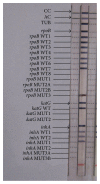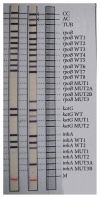Primary Multidrug Resistant Tuberculosis and Utility of Line Probe Assay for Its Detection in Smear-Positive Sputum Samples in a Tertiary Care Hospital in South India
- PMID: 27099794
- PMCID: PMC4821965
- DOI: 10.1155/2016/6235618
Primary Multidrug Resistant Tuberculosis and Utility of Line Probe Assay for Its Detection in Smear-Positive Sputum Samples in a Tertiary Care Hospital in South India
Abstract
In a high tuberculosis burdened country like India, rapid, cost-effective, and reliable diagnostic tools for tuberculosis are an urgent need of the hour to prevent inappropriate treatment strategies and further spread of resistance. This study aimed to estimate the proportion of new smear-positive tuberculosis cases with primary resistance to rifampicin and/or isoniazid as well as identify the common mutations associated with it. Sputum of 200 newly diagnosed smear-positive cases of 1+ score and above was directly subjected to Line Probe Assay using the GenoType MTBDRplus assay kit. All samples were inoculated onto solid media and 61 samples were inoculated in automated liquid culture also. The Line Probe Assay gave hundred percent interpretable results with 2.5% of the study population showing resistant pattern. Only 1% of the cases were primary multidrug resistant tuberculosis and 1.5% showed isoniazid monoresistance. S531L and C15T were the most common genetic mutations seen for rifampicin and isoniazid resistance, respectively. 40% had absent rpoB wild type 8 band indicating probable silent mutation after clinical correlation. The average turnaround time for Line Probe Assay was far less (3.8 days) as compared to solid and liquid cultures (35.6 days and 13.5 days, resp.).
Figures







Similar articles
-
Evaluation of genotype MTBDRplus VER 2.0 line probe assay for the detection of MDR-TB in smear positive and negative sputum samples.BMC Infect Dis. 2017 Apr 17;17(1):280. doi: 10.1186/s12879-017-2389-6. BMC Infect Dis. 2017. PMID: 28415989 Free PMC article.
-
Line probe assay for detection of rifampicin and isoniazid resistant tuberculosis in Pakistan.J Pak Med Assoc. 2012 Aug;62(8):767-72. J Pak Med Assoc. 2012. PMID: 23862246
-
Profile of drug-resistant-conferring mutations among new and previously treated pulmonary tuberculosis cases from Aligarh region of Northern India.Int J Mycobacteriol. 2018 Oct-Dec;7(4):315-327. doi: 10.4103/ijmy.ijmy_98_18. Int J Mycobacteriol. 2018. PMID: 30531028
-
Rapid detection of extensively drug-resistant (XDR-TB) strains from multidrug-resistant tuberculosis (MDR-TB) cases isolated from smear-negative pulmonary samples in an Intermediate Reference Laboratory in India.Indian J Tuberc. 2016 Jul;63(3):144-148. doi: 10.1016/j.ijtb.2016.07.009. Indian J Tuberc. 2016. PMID: 27865234
-
Utility of GenoType MTBDRplus assay in rapid diagnosis of multidrug resistant tuberculosis at a tertiary care centre in India.Indian J Med Microbiol. 2012 Jan-Mar;30(1):58-63. doi: 10.4103/0255-0857.93034. Indian J Med Microbiol. 2012. PMID: 22361762
Cited by
-
Feasibility of Direct Sputum Molecular Testing for Drug Resistance as Part of Tuberculosis Clinical Trials Eligibility Screening.Diagnostics (Basel). 2019 May 30;9(2):56. doi: 10.3390/diagnostics9020056. Diagnostics (Basel). 2019. PMID: 31151255 Free PMC article.
-
Highly Sensitive Detection of Isoniazid Heteroresistance in Mycobacterium Tuberculosis by Droplet Digital PCR.Infect Drug Resist. 2022 Oct 28;15:6245-6254. doi: 10.2147/IDR.S381097. eCollection 2022. Infect Drug Resist. 2022. PMID: 36329987 Free PMC article.
-
[Mass spectrometry-based identification of new serum biomarkers in patients with multidrug resistant pulmonary tuberculosis].Nan Fang Yi Ke Da Xue Xue Bao. 2019 Dec 30;39(12):1409-1420. doi: 10.12122/j.issn.1673-4254.2019.12.04. Nan Fang Yi Ke Da Xue Xue Bao. 2019. PMID: 31907157 Free PMC article. Chinese.
-
Culture positivity of smear negative pulmonary and extrapulmonary tuberculosis- A study from North Kerala, India.J Family Med Prim Care. 2019 Sep 30;8(9):2903-2907. doi: 10.4103/jfmpc.jfmpc_424_19. eCollection 2019 Sep. J Family Med Prim Care. 2019. PMID: 31681664 Free PMC article.
-
Cost minimization analysis of line probe assay for detection of multidrug-resistant tuberculosis in Arkhangelsk region of Russian Federation.PLoS One. 2019 Jan 29;14(1):e0211203. doi: 10.1371/journal.pone.0211203. eCollection 2019. PLoS One. 2019. PMID: 30695043 Free PMC article.
References
-
- World Health Organization. Global Tuberculosis Report 2015. Geneva, Switzerland: World Health Organization; 2015.
-
- Regional Office for South-East Asia. Tuberculosis in South East Asia Region, Annual TB Report 2015. New Delhi, India: World Health Organization-SEAR; 2015.
-
- Drug-Resistant TB. Global TB Report. Geneva, Switzerland: World Health Organization; 2014. Surveillance and response, supplement.
-
- WHO. Policy Statement. WHO; 2008. Molecular line probe assays for rapid screening of patients at risk of MDR-TB. http://www.who.int/tb/features_archive/policy_statement.pdf.
-
- TB India. Revised National Tuberculosis Control Programme Annual Status Report. New Delhi, India: Government of India; 2014.
LinkOut - more resources
Full Text Sources
Other Literature Sources

